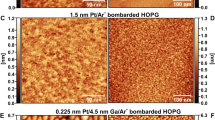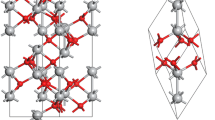Abstract
Rh(100), Pt(100), and Pt-Rh(100) surfaces are inert for the dissociative adsorption of N2, but they are active for the catalytic reaction of NO with H2 During the reaction on Rh(100) and Pt-Rh(100) surfaces, N atoms are accumulated by making a c(2x2)-N overlayer, but no accumulation of N atoms occurs on Pt(100) surface. The fact that N atoms on the Pt-Rh(100) surface gives the c(2x2) structure indicates that the N atoms have equal affinity to Pt and Rh on the alloy surface. When the c(2x2)-N surface was exposed to H2 of 10-7 to 10-8 Torr, a prominent loss peak being assignable to NHx appeared at 3200 – 3240 cm-1 at around 400 K. The in-situ HREELS study proved that NH are prominent species which are formed during the hydrogenation of the c(2x2)-N, that is, a quasi-equilibrium of N + 1/2 H2 - NH is established. When a clean Pt-Rh(100) (Pt/Rh = 1/3) alloy surface is exposed to NO at about 440 K, the LEED pattern changes sequentially as (1x1) → c(2x2) → c(2x2) + p(3x1) → p(3x1), where the c(2x2) pattern appears instantaneously on the alloy surface of any Pt/Rh ratio but the p(3x1) pattern accompanies a certain characteristic interval times being responsible to the segregation of Rh. The p(3x1) surface reflects the formation of an intermediate of Rh-O complex overlayer and it reacts rapidly with H2.
Similar content being viewed by others
References
cf. D.O. Hayward and B.M.W. Trapnell, Chemisorption, Butterworths, London, 1964; cf. A.F. Wells, Structural Inorganic Chemistry, 5th Ed., Clarendon Press, Oxford, U.K., 1984, p. 207.
T. Yamada, T. Misono, K. Tanaka and Y. Murata, J. Vac. Sci. Technol., A7(1989)2808.
I. Matsuo, J. Nakamura, H. Hirano, T. Yamada, K. Tanaka and K. Tamaru, J. Phys. Chem., 93(1989)7747; T. Yamada, I. Matsuo, J. Nakamura, Xie Maosong, H. Hirano, Y. Matsumoto, and K. Tanaka, Surf. Sci., 231(1990)304.
T. Yamada and K. Tanaka, J. Am. Chem. Soc., 111(1989)6880.
H. Hirano, T. Yamada, K. Tanaka, J. Siera, and B.E. Nieuwenhuys, Surf. Sci., 222(1989)179.
K. Tanaka, H. Hirano, and M. Taniguchi, 61st Annual Meeting of Chem. Soc. Japan, 1E2–33, Tokyo, 1991.
I.C. Bassignana, K. Wagemann, J. Kuppers, and G. Ertl, Surf. Sci., 175(1986)22; W. Erley and H. Ibach, Surf. Sci., 119(1982)L357.
T. Yamada, J. Siera, H. Hirano, B.E. Nieuwenhuys, and K. Tanaka, Vacuum, 41(1990)115.
T. Yamada and K. Tanaka, J. Am. Chem. Soc., in press.
H. Hirano, Master thesis of the University of Tokyo, 1990.
H. Hirano, T. Yamada, K. Tanaka, J. Siera, and B.E. Nieuwenhuys, Vacuum, 41(1990)134; H. Hirano, T. Yamada, K. Tanaka, J. Siera, and B.E. Nieuwenhuys, Surf. Sci., 222(1989)L804.
Author information
Authors and Affiliations
Rights and permissions
About this article
Cite this article
Tanaka, K.I., Yamada, T. Structure and reactivity of intermediates. N-overlayer on Pd(100), Rh(100) and Pt-Rh(110) and its reaction with H2 . Res Chem Intermed 15, 213–224 (1991). https://doi.org/10.1163/156856791X00336
Received:
Accepted:
Issue Date:
DOI: https://doi.org/10.1163/156856791X00336




